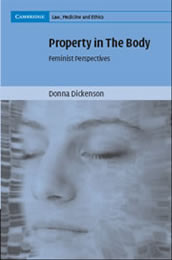BOOK REVIEW
PROPERTY IN THE BODY: FEMINIST PERSPECTIVES
By Donna Dickenson,
Cambridge: Cambridge University Press, 2007, 222 pp, £60.00 (hardback), £23.99 (paperback), ISBN-13: 9780521867924 (hardback), ISBN-13: 9780521687324 (paperback).

Download options |
 |
|
DOI: 10.2966/scrip.050208.447 |
||
In a refreshing application of philosophical scholarship of the feminist genre, Donna Dickenson brings some novel perspectives to bear on the persistent debate regarding the existence and (if so) extent of property rights in the human body.
Why the debate in the first place? Recent cases on both sides of the Atlantic underscore current and increasing concerns regarding the loss (or lack) of property rights in the body. In AB v Leeds Teaching Hospital NHS [2005] 2 WLR 358, Gage J held that parents’ property interests in the mutilated bodies of their deceased children are not sufficient to ground an action for conversion or any other property-based cause of action. Consequently, property remedies were unavailable for the claimants/parents in that case who discovered to their shock that the defendants retained some paediatric organs and other body parts of the claimants’ deceased children without the authority of the claimants (and in some cases, contrary to their express stipulations). As far as body parts are concerned, the case further illustrates the limitations of an action based in negligence, which has over the years been hedged with difficult control mechanisms developed by the appellate courts in the UK. Unsurprisingly, only one of the three groups of claimants in AB v Leeds succeeded in negligence. US jurisprudence generally exhibits the same trend. In the Colavito line of cases, it was held that the misdirection of a directly donated kidney did not in the circumstances of that case occasion any deprivation of property (Colavito v N.Y. Organ Donor Network, No. 1, 356 F.Supp.2d 237 at 241-247 (E.D.N.Y. 2005); Colavito v New York Organ Donor Network, No.2, 438 F.3d 214 (2006); Colavito v New York Organ Donor Network (No. 3), 8 N.Y.3d 43 at 53 (2006, CANY); Colavito v New York Organ Donor Network (No. 4), 2007 WL 1462399 (2nd Cir. N.Y) In Washington University v Catalona 437 F.Supp.2d 985 (Dist. Ct. Missouri, 2006), it was equally held that tissue donors (for research) did not have sufficient property rights in their tissues to control the subsequent management and transfer of those tissues. If we accept that these judgments are not surprising in view of the ancient no-property rule in dead bodies and body parts (Haynes’ Case [1613] 12 Co. Rep. 113), then we need to deeply examine the basis of our current and heightened concern about the non-recognition of property rights in our own bodies and in our body parts. This is one of the mysteries that this book tries to unravel.
Dickenson posits that current concerns about the loss or absence of property rights in the human body stems from modern biotechnology’s feminisation of property in the body. In other words, modern biotechnology has extended to the male body the treatment traditionally reserved for the female body. Simply put, female and male bodies are now feminised, so that both have become objects of property. According to Dickenson, this gendered rationale, as much as the fear of commodification, accounts for the current uproar regarding the objectification and commodification of the human body. This is the crux of Dickenson’s book. Dickenson ably demonstrates the historical underpinnings of her thesis. She does so through the accessible and interlinked chapters exploring the historical objectification of the female body as manifested in their status of propertylessness and oscillation between person and object. Dickenson’s historical account, which draws from her previous book, ranges from a woman’s status in Athens as somebody just a little more than a slave (but less than a full subject), through liberal theory’s denial of political rights to women based on their perceived inferiority to men and propertylessness, to modern biotechnology’s extensive objectification of the female body through stem cell technologies (involving the extraction of ova) and umbilical cord blood banking. As Dickenson observes, it is worrisome that the commodification debate is not prompted by concerns about the exploitation of women; rather, it is triggered by the realisation that both female and male bodies are now open to exploitation by the application of modern techniques of biotechnology. Dickenson’s account of the debate surrounding biopatents and biobanking (where the gender of the DNA is irrelevant to the technologies involved) provides sufficient support for her thesis. In order to combat the objectification and commodification of the human body, Dickenson suggests the recognition of a modified (or limited) form of property rights in the human body. This should be based on the bundle of rights theory of property which allows for a differentiated application of property protection.
The property-based rule suggested by Dickenson is timely and beneficial, especially as the consent framework alone is insufficient for dealing with most of the issues raised in litigation relating to the human body. This book is well-written and is a pleasure to read. It combines approaches in law, philosophy and bioethics. It is a must read for people interested in bioethics or in the law relating to dead bodies and body parts; it is also highly recommended for the general reader.
Dr Remigius N. Nwabueze,
School of Law,
University of Southampton,
Southampton, UK.
© Remigius N. Nwabueze 2008

This work is licenced under a
Creative Commons Licence.
Please click on the link to read the
terms and conditions.
